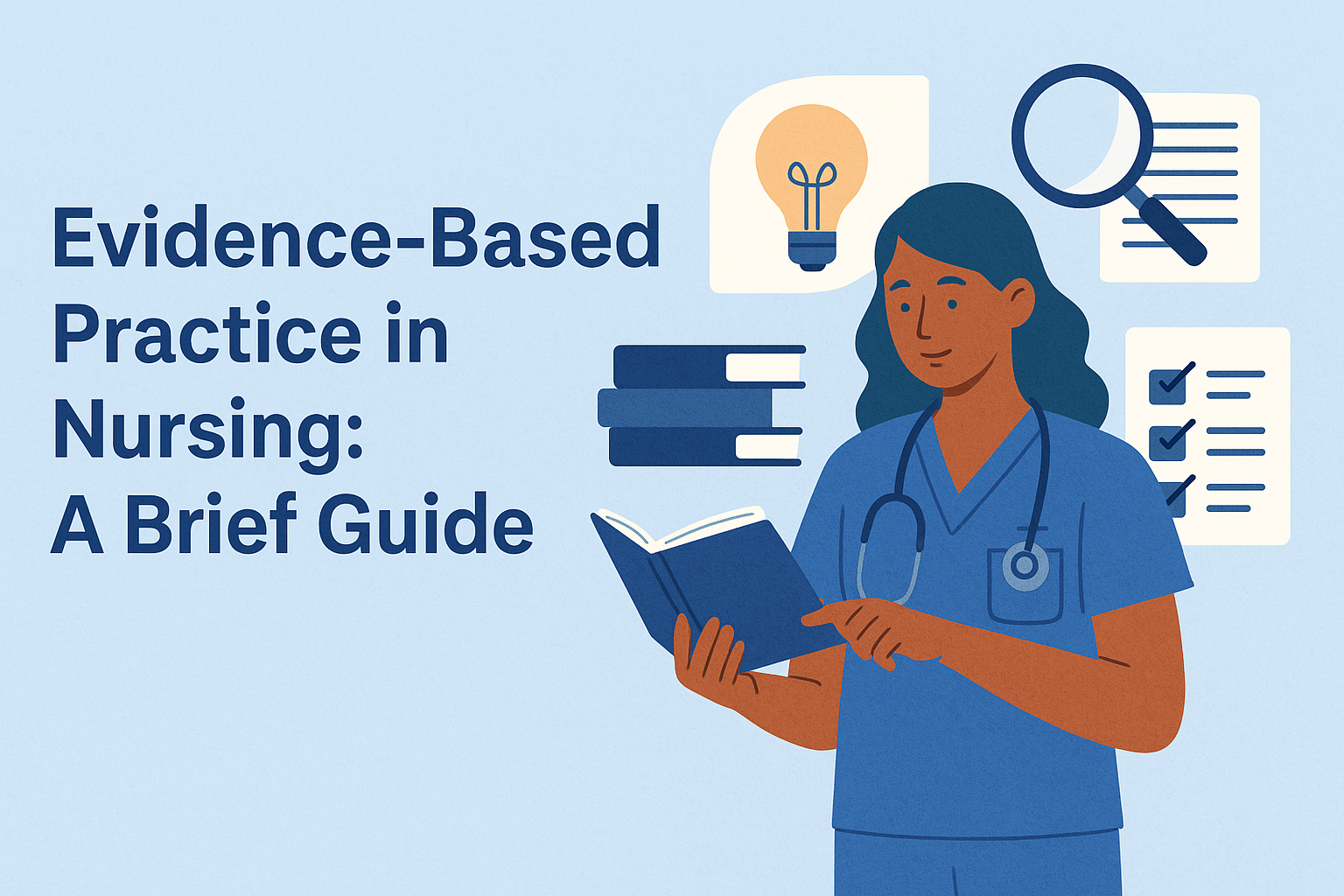A 2022 study published in the Journal of Population Therapeutics and Clinical Pharmacology clearly states that there is a strong connection between nursing practices adhering to EBP and better patient outcomes. In the study, a retrospective review was conducted on a random sample of 10,000 patient records from 2017 to 2019, indicating a significant reduction in in-hospital complications, shorter hospital stays, and lower mortality when EBP was followed.
Evidence based practice in nursing is central to delivering the best patient care, enhancing nursing expertise and ensuring patient satisfaction. Going beyond routine and traditional care, EBP provides patients with care that not only follows scientific principles but also aligns with what the patient values and respects.
Let’s have an in-depth look at this area of nursing:
What is Evidence Based Practice? The Foundation
When we say evidence based practice in nursing, it means a systematic and strategic approach to making clinical decisions involving the following core elements:
-
What does the current and reliable nursing research say about the matter at hand
-
How a nurse observes the research and findings based on their own nursing expertise, experience and knowledge
-
And what the patient values, feelings and beliefs are regarding the approach
A nurse adhering to evidence based practices will follow these core elements in this way: they will refer to a reputable nursing research database when it comes to offering the best care to their patients. However, they will not solely rely on the scientific principles; rather, they will combine them with their own nursing experience and the knowledge they have gained during clinical practice. After the two are integrated, they will then discuss the care with the patient. If something goes amiss with what the patient values and feels, then the nurse will reconsider their remedies, developing alternatives that comply not only with current research evidence but also suit patient satisfaction. Let’s understand it further with an example:
Evidence Based Practice: A Practical Example
Suppose a patient is being cared for with pressure ulcers. To develop high quality and patient focused care methods, the nurse turns to current and reliable research/evidence.
-
The nurse finds from research that turning the patient every two hours and using pressure relieving mattress helps prevent pressure ulcers.
-
Now, based on their own practical experience and nursing knowledge, the nurse knows that some patients experience discomfort with a certain type of cushioning and that frequent turning every 2 hours at night can impact their mood and the healing process.
-
When the patient hears the prevention remedy, they say that they value uninterrupted sleep at night, and frequent turning will exhaust them.
Considering all these factors, the nurse must make a balanced clinical decision that takes into account all these aspects. So,
-
The nurse discusses it with the patient.
-
Both agree on a turning schedule, frequent turning during the day and less during the night.
-
The nurse uses a high-tech pressure-relieving mattress that suits both the patient's comfort and is also effective in preventing pressure ulcers.
How is Evidence Based Practice Applied? The Steps
The following steps reflect how an EBP based clinical decision should be made:
Formulate a Clinical Question
The first step in evidence based practice is to develop a question relevant to the patient's issue or clinical matter. The question should be focused, specific and clear. Generally, a PICO format is applied in this matter, which includes:
Patient/Problem
Bedridden elderly patients
Intervention
Frequent turning every 2 hours
Comparision
Repositioning every 4 hours
Outcome
Reduction or prevention of pressure ulcers.
A question using this format will look like this: “In an elderly bedridden patient, does repositioning every 2 hours compared to 4 hours result in pressure ulcer prevention and reduction?”
Searching for Evidence
Once the question is developed, the next step is to find credible and relevant evidence as an answer. For that, the nurse must deeply explore comprehensive research sources using reputable databases, including PubMed, Cochrane Library or CINAHL. Research sources may include systematic reviews, clinical guidelines and authentic studies.
Critical Appraisal of the Evidence
Now the nurse must assess the gathered evidence before proceeding with it. In this step, evidence is thoroughly evaluated to check its reliability, validity and clinical applicability. The nurse might use the following questions to do so:
-
Was the study peer-reviewed?
-
Was the sample of the study similar to their patient population(elderly and immobile in the case of the above example)
-
Was the outcome of the study reliable?
Checklists and appraisal methodologies can be used to evaluate the chosen evidence successfully.
Integration of Clinical Expertise and Practical Application
Here, the nurse combines the chosen evidence with their own clinical expertise and what their patient values. The nurse assesses how the practical application of the evidence in the given clinical situation fits with their patient care, comfort and values.
For example, the evidence suggests repositioning every 2 hours, but the patient complains of discomfort at night. Hence, using their clinical knowledge, the nurse devises their own repositioning schedule and utilises a high-tech mattress to relieve the pressure at night when frequent repositioning is not possible.
Assessment of Outcomes
Throughout the intervention and implementation, the nurse documents the patient’s condition status. It involves recording data, closely monitoring the patient’s condition and reflecting on results.
For example, after 2 weeks:
- There is no sign of ulcer development
- The patient sleeps comfortably at night
- The nurse documents the intervention as successful.
If there is any discomfort or worsening situation, the nurse will reassess the methodology and will use the adjusted care plan.
Final Word: Significance of Evidence Based Practice
Clinical decisions made based on EBP are proven to be successful and effective because they are patient-centred, scientifically supported, and involve critical appraisal from a nursing perspective. This is why this practice is being reinforced in many healthcare centres, requiring nurses to be actively engaged with this model on duty.
Organisations are offering their nurses access to reputable research databases, providing evidence based practice writing service using training programs and also mentorship through nursing experts.
Nursing education programs also make evidence-based practice writing an integral part of their curricula, instilling understanding and skills relevant to this practice from the very start.
With proper adherence to this model, nurses not only succeed in delivering quality patient care but also ensure continual professional development, a substantial aspect of their profession. So, if you are aiming to choose this profession or are in the midst of becoming one, mastering evidence-based practice is a given. Start today for lifelong learning and professional credibility.











